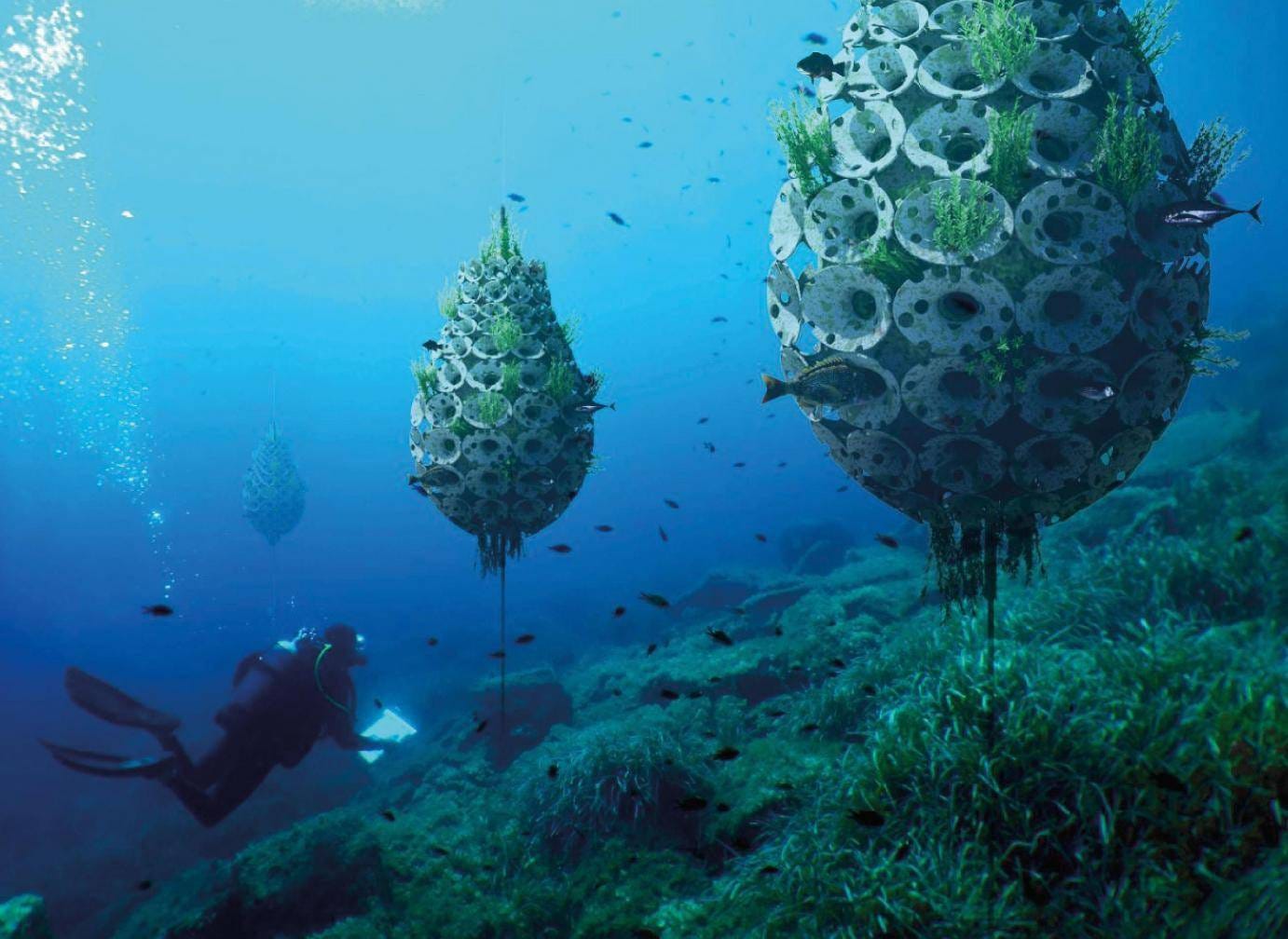Forever Thrilled, Part 16
Chapter 5: A Wave of Hypersea

They have to go outwards—in the radial direction—before they can go up. Since their axial speed is so high, they’re slowly spiraling outwards. As such, they’re gradually moving out of the central cloud torus and into a superstorm riddled with torrential rains, colossal lightning, and thunderbolts so loud, they might even be noticed by the hypersounders (if these were in their original environment), even if merely as just above silence.
With her magnetometers set to maximum sensitivity, Na-Yeli tries to determine where the next lightning flash might be, but it’s pointless. Due to their stupendous rotational speed, their maneuverability is limited. On top of that, the area is so turbulent and massively chaotic that predicting the exact position of the next lightning strike is all but impossible. Like a little drone caught in a summer thunderstorm, they’ll have to keep going and hope for the best.
So far, they haven’t been struck by lightning yet, but Na-Yeli knows their luck can’t last. So she frantically checks the integrity of the Faraday cage she set up in their exoskin, only to find that it’s deteriorating. How the hell is that possible? She wonders, We’re only experiencing wind—admittedly, extremely fierce wind—and rain. Structurally, her exoskin should be able to withstand brutal winds, even these extremely excessive ones. She’s set the very outer layer of their exoskin metamaterials to the hardest setting possible: almost as hard as diamond, nearly as resilient as the best amorphous metal alloy.
Then she checks the integrity of the outer layer to find it’s in even worse shape than the Faraday cage. It shouldn’t be possible. Na-Yeli thinks, It should be able to take the impact of wind and water. Because it is rain, her spectrometer has confirmed that the clouds are water vapor. However, what were the other elements in the atmosphere? She rechecks it, and realization strikes her. Hydrogen and Chloride, Na-Yeli figuratively slaps her head, This rain is as acidic as possible.
Acid that’s etching her outer layer, and subsequently her Faraday cage. She immediately reprograms her metamaterials to transform the very outer layer into an acid-resistant type (hoping the strength will still be sufficient), sets out to neutralize the acid still in their system with a basic solution, and then reinforces their Faraday cage to its original strength.
The repairs are underway, moving with the greatest haste, but have barely reached the halfway point as a massive ZAP envelops them!
Na-Yeli feels the electric burn in her soul as she and the exoskin are almost one. Two out of three quantum computers down, all non-essential systems switched off, including the communication AI and most of her outer sensors. The servomotors controlling her wings, flaps, and stabilizers have also burned out, so her autopilot sends out its command in vain. The hypersounder simulation is frozen—they should be able to restart it if normal functionality of all quantum computers is restored—and Na-Yeli quietly thanks herself for rating it as an essential system. Thankfully, her shock absorbers still work—they’re highly autonomous—otherwise, the forces that throw her around in this mega-cyclone would have broken all her bones.
Don’t panic, she thinks fervently, as she must now carefully use her remaining resources. They’re thrown around like a teacup in a tempest, but so far, that’s not deadly. First, exoskin integrity must be restored; otherwise, the next lightning strike will literally fry them to kingdom come (well, more like kingdom gone). So all their remaining abilities are put forward to fixing that. Otherwise, she’s blind, deaf, and lame—her outer sensors are down, and there’s no way to effectively operate her wings, stabilizers, and flaps in this mother of all storms.
Still, she does ‘feel’ something as the integrity of her exoskin slowly increases. Four pressure points that vary in force very wildly and quickly. Strange and stranger. Also, the fierceness of the storm seems to abate, which—Na-Yeli knows deep into her scientific soul—is impossible. Yet they’re bumped around much less fiercely. Could it be, Na-Yeli thinks, feeling tender at the thought, the Moiety Alien trying to stabilize our flight?
Hopefully, she’ll find out soon. The outer skin is restored to almost 99%, and the Faraday cage is restored to 98% as the next massive ZAP! strikes them. Na-Yeli fears the worst, but finds out that they’ve come out largely unscathed—that is, their already very consequential damage hasn’t become worse. Thank dog for little mercies.
Once her exoskin is fully restored, Na-Yeli can redirect her resources to fixing the rest of the overloaded systems. While she did feel quite unhappy about relying on one single quantum computer only—she loves triple redundancy—she’s relieved she decided to fix their protection first. Now, to get the rest of their systems up before they crash into the ocean. The quantum computers are photonically robust and can be restored from a Heisenberg backup. However, the nano-restoration machines need time to rebuild and reboot, meaning some repair capacity becomes available. On to the outer sensors it goes.
One by one, her outer cameras come back online. A few are recording images of the Moiety Alien, very up close and personal. It’s indeed keeping us stabilized, Na-Yeli thinks, a friend in need...
Just as the second quantum computer returns online, Na-Yeli & Co are hit by the third mega-ZAP! The only things it frays this time are her nerves. While she sees the inner systems being restored, and Na-Yeli knows she can trust the outer shielding now, she still feels uneasy. While she realizes that she wouldn’t survive in all these extreme environments without the army of main and auxiliary systems—most of them as 3D-print-on-demand, if sufficient materials are available—she still likes to feel in control by piloting the lot of them.
In any case, as the second quantum computer is back up and running, she decides to get the hypersounder simulation going. On the one hand, it should not matter how long the simulation is frozen, as it’s supposed to ‘unfreeze’ trouble-free at any time (given sufficient computing power). On the other hand, it makes Na-Yeli feel better. She knows, she knows, she’s supposed to be a scientist, an engineer who trusts her systems, but in times of high stress, she sometimes reverts to (semi-)irrational human habits. She can always be embarrassed later.
The simulation seems to restart without a glitch, but to be sure, Na-Yeli needs to contact the hypersounders, which she can’t do without the communication AI. And the communication AI is at the bottom of the priority list, so she can only reboot it after her third quantum computer, autopilot, and flight controls are fully functioning. Oh shit, she thinks, I’ve woken them up only to keep them in the dark. Mushrooms, at least, get shit with that.
All the flight controls test out okay, even if a few of them report being blocked by an outside force—the Moiety Alien stabilizing them. Na-Yeli extends a temporary pseudopod to gesture ‘away’ to the Moiety Alien, who only seems to let go reluctantly. Of course, Na-Yeli & Co are thrown around like a paper airplane in a tropical cyclone, but not for long. The autopilot kicks in, and their flight stabilizes fairly quickly using the backup of the algorithms it found earlier.
Once all systems are go—Na-Yeli almost forgets to restart the communication AI—she pseudopods a quick thumbs up to the Moiety Alien, and assesses their situation. They’ve gone down quite a bit—the water wall, speckled white with frothing waves—seems less than a kilometer down (for your version of ‘down’ in this tilted world). As they approach the sea, they need to find a way to slow down before they dive in. Water is quite unforgiving at stupendously high speeds. A rapid turnaround loop—just above the water—where their return speed almost equalizes the mega-cyclone’s wind speed should do the trick, and then speed up and dive in, more or less with the rotational speed of the ocean (which her lasers measure at about a whopping six-hundred-and-sixty kilometers per hour).
The problem is that ‘just above the water’ is hard to define. The sea is far from flat as the mega-cyclone tries to whip up high waves. However, through the centrifugal action representing about 0.25 G—or about twice the gravitational pull of the naked singularity in this layer—the waves are not as stupendously high as the soliton exemplars she encountered on her way in. It’s probably also to do with the huge rotational speed of the sea. No near-perfect queue of twelve, three-kilometer-high soliton waves, but rather a roaring ocean with unpredictable wave heights. She still estimates the highest waves to be about two hundred meters. In this extremely chaotic environment, she’ll have to make it up as they go along.
She continues in her downward spiral, one more massive ZAP! reminding her that they’re crossing lateral lightning, as well.
—what’s going on— the communication AI signals —i thought we were in for an exciting ride—
“We were almost struck down,” Na-Yeli says, “by the hammer of Thor. Report later, too busy now.”
—alright cap’n—
With the indispensable help from the autopilot, Na-Yeli steers them down until they almost scale the tops of the highest waves. She needs to get a feel for the water before she dives in. She stares at the mightily frothing ocean, wondering if she should use the hypersounders’ innate connection with chaos again, but increasingly, something else is bothering her. And the relentless barrage of noisy thunder doesn’t help her concentration, either.
The fast-rotating ocean surface—the inner wall of the superswirl—is white with spume. But there’s something else that’s white if Na-Yeli’s eyes don’t fool her, and it’s not just the reflection of the lightning. Everything moves so fast, making it extremely hard to be sure, so she points her high-speed cameras at the places that bother her.
—why aren’t we diving in— the communication AI signals —haven’t we been here long enough already—
Give them the finger of communication, Na-Yeli thinks, and before you know it, they’ll want the arm of control. “Your captain senses that something’s off,” she says, “possibly dangerously off, and is studying it. We’ll go in once I deem it safe. Unless you wish to take control?” If the communication AI didn’t hear the intonation of her last sentence now, it never will.
—no ma’am//aye ma’am//carry on ma’am— the communication AI stumbles over its own voice output —at your command, ma’am—
“Good,” Na-Yeli says, “Please remain quiet while I consider my options.”
She goes through the high-speed camera recordings, looking for order out of chaos. There, something’s there. She slows down the recording and zooms in. Indeed, there’s something below the surface, faintly lit. Here comes an army of extra photons by dint of a nearby lightning strike. Go back, slow down, a few frames forward, a few back. There it is: an underwater structure not unlike a ghostly coral reef. It goes with the flow; that is, it moves just as fast as the inner water wall at six hundred and sixty kilometers per hour.
A floating coral reef, Na-Yeli thinks, I don’t want to slam into that. So, she’ll have to choose her point of entry even more carefully because she is fairly certain she’s spotted more than one. Also, if her observational skills are not fooling her, they seem more likely in the areas where the lightning strikes more often. And that is one thing her pattern-analyzing software agrees with, after numerous observations, there are certain spots in the water wall—while taking its rotational speed into account—that get considerably more lightning strikes than others. Now, either the coral reefs outside the ‘lightning-does-strike-more-than-once’ places are less visible or less likely to be there. Na-Yeli suspects the latter, and the pattern-analyzing software agrees with her.
Hence, they have to do a quick peek-a-boo before they dive in. It’s almost as if there’s some malevolent dog—steadfastly agnostic Na-Yeli refuses to use the term ‘god’—that sadistically increases their challenges as they come back to the layers they’ve traversed before. Then again, after the Strange Hail, Na-Yeli’s ready to face anything. So she steers them down, looking for that perfect spot to dive into.
Quickly, she updates her crew. “Moving towards the fast-rotating sea—the superswirl, if you will. Flying well above the huge waves to find the best entry point. We must avoid structures that look like floating coral reefs, which we’ll explore if we get into the water without breaking apart. It’ll be rough, and entry will come with a huge slap.”
—aye, cap’n— the communication AI signals —the hypersounders say ‘supercool’—
The problem is, she has to look very far ahead, as they’re progressing at well over two-point-four-thousand kilometers per hour; they’re moving eighteen hundred clicks faster than the wildly churning water. After some harrowing trial-and-error, Na-Yeli finds it best to stay five hundred meters above the highest waves, probably the best look ahead/dive-in ratio at the velocities with which they’re moving.
She’s spotted a few of these floating coral reefs but also spots where they definitely were not. Also, at their tremendous speeds, they complete a full rotation in fifty-one seconds. By now, she knows where to expect the floating coral reefs—and most of the lightning—and where to expect more empty stretches of water—with much fewer lightning strikes. Far in the distance, she sees one of the ‘empty’ areas rise up as a huge wave, and she makes her choice. Typically, she’s struck for the fifth time by a massive lightning bolt, but she’s so utterly concentrated now that she merely shakes it off.
Getting closer, she makes a return downwards loop until she’s slowed down to about the rotating water’s speed, the Na-Yeli craft vibrating like mad as the autopilot frantically tries to stabilize them. Then she turns again and moves towards the huge wave, zigzagging like crazy to avoid excessive speed buildup towards the wave. Closer and closer it comes until they’re almost swallowed by it. At that very moment, Na-Yeli points them straight into the monster wave and dives in.
They experience a fierce shock as they connect with the water, but it’s within the limits of what they can withstand. Her instruments read a velocity difference of about seventy-five kilometers per hour at the moment of entry. Inadvertently, Na-Yeli nods as she quickly moves them deeper into the water to prevent them from shooting out of the wave again. Then she looks around to see the Moiety Alien following them at a short distance. Its maneuverability and impact resistance are incredible, she thinks, It’s almost as if they were born—nay evolved—for this.
Once they’re at a safe depth, they can do two things. One, move onwards as fast as possible to the next water wall in the northern hemisphere of this layer. Two, check out one of these floating reefs. Curiosity gets the better of Na-Yeli—after all, what’s a few more hours compared to all the time they lost inside the Core—and she carefully heads towards the area where she’s noticed the closest coral reef.
Support this writer:
Like this post!
Re-stack it using the ♻️ button below!
Share this post on Substack and other social media sites:
Join my mailing list:
Author’s note: my arm’s been sore for a couple of days from a combined flu and pneumococci shot, and tomorrow I’m getting a Covid vaccination (with a chance of more soreness). On the other hand, one of my co-workers was ill for two weeks from—what he thinks—was the flu. I suspect, from the symptoms he mentioned, it was probably Covid, but he didn’t test for it (which I find strange, as our company provides free test kits—I still have eight of them).
Just to say Autumn and flu (or its evil cousin Covid) season is upon us, so take care! A sore arm—IMHO—is a small price to pay to avoid (long) Covid. On the other hand—devil’s advocate—if you’re only mildly ill, you can stay at home and read stories, like this one…;-)
Many thanks for reading, and welcome to a new subscriber!





